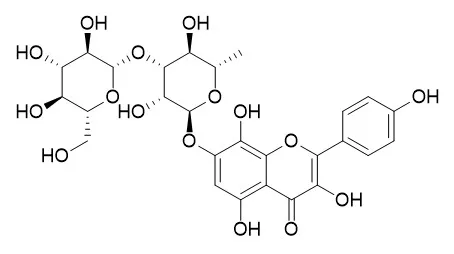| Kinase Assay: |
| Pharmazie. 2013 Dec;68(12):974-6. | | Two potent cytochrome P450 2D6 inhibitors found in Rhodiola rosea.[Pubmed: 24400445] | Throughout the world, in particular in Russia, Northern Europe and China, Rhodiola species are used as herb supplements. Previously, we found that the extract of Rhodiola rosea, one of the most widely used Rhodiola species, had an inhibitory effect on the catalytic activity of cytochrome P450 2D6. Here, its inhibitory components were identified.
METHODS AND RESULTS:
A human liver microsomal in vitro system was used with dextromethorphan as substrate. The production rate of destrorphan, a metabolite of dextromethorphan, was used to measure enzyme activity. The concentration of destrorphan in the samples was measured using LC-MS/MS. Inhibitory activity of eight main components from Rhodiola rosea was evaluated.Rhodiosin and rhodionin showed inhibitory activity with IC50 values of 0.761 microM and 0.420 microM, respectively. The other components showed no obvious inhibition (with a residual enzyme activity of more than 90%). Both Rhodiosin and rhodionin were determined to be non-competitive inhibitors with Ki values of 0.769 microM and 0.535 microM.
CONCLUSIONS:
Two of the main Rhodiola rosea compounds, Rhodiosin and rhodionin, can inhibit cytochrome P450 2D6 non-competitively with high specificity which could have implications for interactions with co-administered drugs. |
|
| Structure Identification: |
| Chem Pharm Bull (Tokyo). 2001 Apr;49(4):396-401. | | Prolyl endopeptidase inhibitors from the underground part of Rhodiola sachalinensis.[Pubmed: 11310664] | The methanolic extract of the underground part of Rhodiola sachalinensis was found to show inhibitory activity on prolyl endopeptidase (PEP, EC. 3.4.21.26), an enzyme that plays a role in the metabolism of proline-containing neuropeptidase which is recognized to be involved in learning and memory.
METHODS AND RESULTS:
From the MeOH extract, five new monoterpenoids named sachalinols A (24), B (25) and C (26) and sachalinosides A (23) and B (27) were isolated, together with twenty-two known compounds, gallic acid (1), trans-p-hydroxycinnamic acid (2), p-tyrosol (3), salidroside (4), 6n-O-galloylsalidroside (5), benzyl beta-D-glucopyranoside (6), 2-phenylethyl beta-D-glucopyranoside (7), trans-cinnamyl beta-D-glucopyranoside (8), rosarin (9), rhodiocyanoside A (10), lotaustralin (11), octyl beta-D-glucopyranoside (12), 1,2,3,6-tetra-O-galloyl-beta-D-glucose (13), 1,2,3,4,6-penta-O-galloyl-beta-D-glucose (14), kaempferol (15), kaempferol 3-O-beta-D-xylofuranosyl(1-->2)-beta-D-glucopyranoside (16), kaempferol 3-O-beta-D-glucopyranosyl(1-->2)-beta-D-glucopyranoside (17), rhodionin (18), Rhodiosin (19), (-)-epigallocatechin (20), 3-O-galloylepigallocatechin-(4-->8)-epigallocatechin 3-O-gallate (21) and rosiridin (22).
CONCLUSIONS:
Among these, nineteen compounds other than 3, 4 and 9 have been isolated for the first time from R. sachalinensis, and six (6, 8, 13, 16, 17, 20) are isolated from Rhodiola plants for the first time. Among them, six compounds (13, 14, 18, 19, 21, 22) showed noncompetitive inhibition against Flavobacterium PEP, with an IC50 of 0.025, 0.17, 22, 41, 0.44 and 84 microM, respectively. |
|






 Cell. 2018 Jan 11;172(1-2):249-261.e12. doi: 10.1016/j.cell.2017.12.019.IF=36.216(2019)
Cell. 2018 Jan 11;172(1-2):249-261.e12. doi: 10.1016/j.cell.2017.12.019.IF=36.216(2019) Cell Metab. 2020 Mar 3;31(3):534-548.e5. doi: 10.1016/j.cmet.2020.01.002.IF=22.415(2019)
Cell Metab. 2020 Mar 3;31(3):534-548.e5. doi: 10.1016/j.cmet.2020.01.002.IF=22.415(2019) Mol Cell. 2017 Nov 16;68(4):673-685.e6. doi: 10.1016/j.molcel.2017.10.022.IF=14.548(2019)
Mol Cell. 2017 Nov 16;68(4):673-685.e6. doi: 10.1016/j.molcel.2017.10.022.IF=14.548(2019)